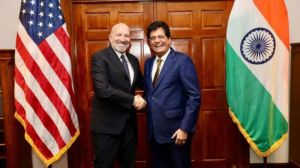Fiscal prudence, monetary policy easing & deregulation as mantras for Viksit Bharat
The Survey also points out the risk of increasing our current account deficit and exhorts us to make FDI more attractive, with an emphasis on tax certainty for investors through advance pricing agreements.
 On the growth front, the Survey states that to achieve our ambition of Viksit Bharat by 2047, the GDP needs to grow annually at 8% in real terms over the next decade. (Express Illustration)
On the growth front, the Survey states that to achieve our ambition of Viksit Bharat by 2047, the GDP needs to grow annually at 8% in real terms over the next decade. (Express Illustration)Economic Survey 2024-2025, presented about six months after the previous Survey, provides updates on the economic front, reflecting the pace of change in the world economy over such a short period.
On the external front, the Survey indicates the resilience of the Indian economy due to healthy forex reserves as well FPI inflows remaining net positive even though there have been large outflows recently. The Survey underlines the trade challenges faced by the global economy, and consequently, the Indian economy, owing to conflicts impacting movement in the Red Sea, besides other geo-political confrontations. It also outlines the challenges posed to our export growth ambitions by non-tariff measures and the Carbon Border Adjustment Mechanism (CBAM) and European Union Deforestation Regulation (EUDR) as well as other measures imposed by our major trading partners. While India’s exports have demonstrated robust growth despite these measures, the Survey highlights the need for diversification of exports as well as efficiencies to bring down the cost of exports and remain competitive. While the net FDI into India has been much smaller compared to the previous year, the strong performance in services exports and robust remittances have supported our balance of payments position.
The Survey also points out the risk of increasing our current account deficit and exhorts us to make FDI more attractive, with an emphasis on tax certainty for investors through advance pricing agreements. It makes a case for more ease of doing business to get higher efficiency out of investments in the face of slowing FDI.
On the inflation front, the Survey presents a detailed analysis of price fluctuations of a few food products such as onions, tomatoes and pulses. It argues that the volatility in prices is owing to extreme weather events.
The Survey points out that core inflation (inflation of non-food items in the inflation basket) has cooled down. The price of commodities in India’s import basket is also expected to come down. This, combined with a likely favourable monsoon leading to cooling of food prices, should aid in inflation moving to the RBI’s targeted levels. The Survey hints that the monetary policy would have very little effect on taming inflation that is linked to food price volatility and suggests measures like high-yield and drought-resistant farming as well as price monitoring and supply-side interventions to address food prices – a gentle nudge to the Monetary Policy Committee (MPC).
On the growth front, the Survey states that to achieve our ambition of Viksit Bharat by 2047, the GDP needs to grow annually at 8% in real terms over the next decade. It compares the nominal growth rate projections by the IMF in its World Economic Outlook and argues that the IMF is expecting only 0.5% annual depreciation in the rupee against the US dollar till FY30 compared to over 3% annual depreciation that it has experienced over the last three decades.
Hence, it expects faster growth in USD terms than achieved in the past. The Survey acknowledges that to be able to do so the investment rate has to increase by 4 percentage points from 31% to 35%, manufacturing has to be boosted and investments have to be undertaken in AI, robotics and biotechnology. It also mentions the need to create over 7 million non-farm jobs, to develop world-class infrastructure at scale and with speed, and of course to skill and enable the workforce to take up these jobs by improving the quality of our education. It acknowledges the role of MSMEs in the growth journey and calls for the regulatory burden to be brought down so that MSMEs have incentives to grow and not stay dwarfs.
The Survey exhorts states to look at not necessarily the best practices but to go for the ‘minimum necessary, maximum feasible’ option for regulation.
The Economic Survey clearly outlines the imperatives for India for it to achieve its aspirations to be a Viksit Bharat. It outlines the need for efficiencies in manufacturing and trade, deregulation by governments at the Centre and more so at the state level, investments in health and education to harness the power of demography, diversification and efficiency in the agricultural sector, as well as the need for adaptation measures in the face of climate change.
The message for fiscal policy is to continue on the path of prudence and provide higher allocations to productive expenditure in infrastructure, health, education, technology and agriculture. The nudge to monetary policymakers is to look at inflation with a different lens and not be captive to the vagaries of food inflation.





- 01
- 02
- 03
- 04
- 05


























